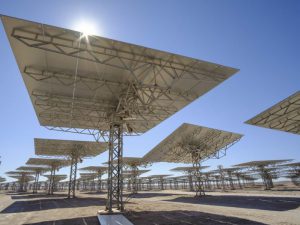The power of the sun has been a source of fascination and inspiration for humans since the dawn of civilization. As our understanding of the universe has expanded, so too has our ability to harness the sun’s energy for practical purposes. One of the most promising developments in this field is the emergence of concentrated solar power (CSP) and integrated thermal storage systems. These technologies have the potential to revolutionize the way we generate and store clean, renewable energy, paving the way for a more sustainable future.
Concentrated solar power, as the name suggests, involves concentrating sunlight onto a small area to generate heat. This is typically achieved using mirrors or lenses that focus the sun’s rays onto a receiver, which then absorbs the heat and transfers it to a heat transfer fluid. This fluid can be used to generate steam, which in turn drives a turbine to produce electricity. The key advantage of CSP over other solar technologies, such as photovoltaic (PV) panels, is that it can generate power even when the sun isn’t shining, thanks to integrated thermal storage systems.
Integrated thermal storage systems are a critical component of CSP plants, as they allow excess heat to be stored during periods of strong sunlight and then released to generate electricity when needed. This effectively turns CSP plants into “dispatchable” sources of power, meaning they can be relied upon to provide electricity on demand, much like traditional fossil fuel power plants. This is a significant advantage over other renewable energy sources, such as wind and solar PV, which are inherently intermittent and therefore require backup power sources or energy storage solutions to ensure a stable supply of electricity.
There are several different types of CSP technologies, each with its own unique set of advantages and challenges. Parabolic trough systems, for example, use curved mirrors to focus sunlight onto a linear receiver tube, which contains the heat transfer fluid. This is the most mature and widely deployed CSP technology, with numerous commercial-scale plants in operation around the world. However, it is also relatively land-intensive, as the mirrors must be spaced out to avoid shading each other.
Another promising CSP technology is the solar power tower, which uses a field of flat mirrors, or heliostats, to direct sunlight onto a central receiver located at the top of a tall tower. This design allows for higher temperatures and greater efficiency than parabolic trough systems, as well as a smaller land footprint. However, it also requires more complex tracking systems to keep the mirrors aligned with the sun as it moves across the sky.
One of the most exciting developments in the field of CSP is the integration of advanced materials and designs to improve the efficiency and reduce the cost of these systems. For example, researchers are exploring the use of nanoparticles and nanofluids to enhance the heat transfer properties of the working fluids used in CSP plants. Similarly, new mirror designs and coatings are being developed to increase the reflectivity and durability of the concentrating elements.
As the world grapples with the urgent need to transition away from fossil fuels and towards cleaner, more sustainable sources of energy, concentrated solar power and integrated thermal storage systems offer a compelling solution. By harnessing the sun’s energy in a more efficient and reliable manner, these technologies have the potential to play a key role in the global shift towards a low-carbon future. With continued research and investment, CSP and integrated thermal storage systems could soon become a cornerstone of our efforts to combat climate change and secure a more sustainable future for all.
energyportal.eu


